Dell Studio XPS 16: the Eyes Have It
by Jarred Walton on April 2, 2009 6:00 PM EST- Posted in
- Laptops
Power Requirements
Power requirements with a laptop plugged in don't necessarily reflect power requirements when a laptop is on battery power. In particular, high-end GPUs run at lower maximum clock speeds when using the battery. Keep this in mind when looking at the following numbers. We test under idle conditions, with a 100% load placed on the CPU via Folding@Home SMP, and finally at maximum load by running FAH SMP at the same time as we loop 3DMark06 (at the native LCD resolution).
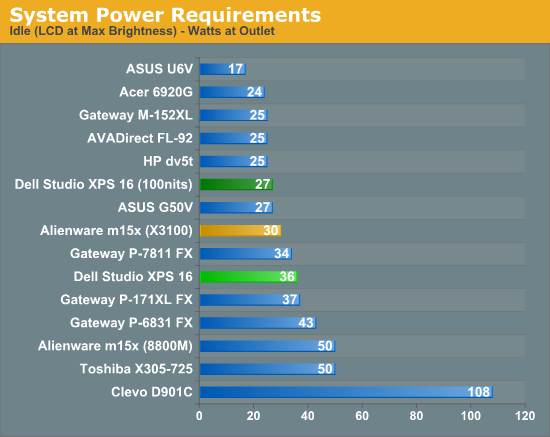
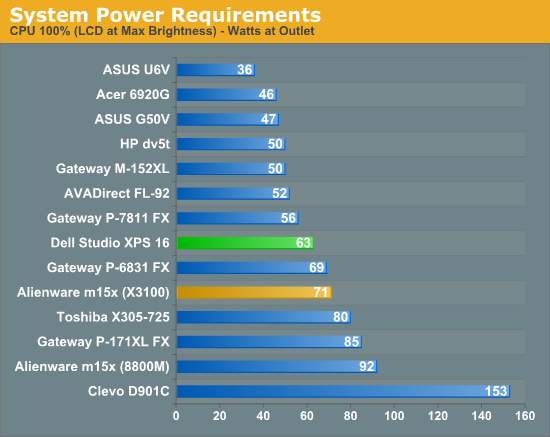

Our power measurements are with the LCD at maximum brightness, which isn't necessarily a fair way of doing things as some LCDs are much brighter than others. Unfortunately, we don't have most of the laptops around to retest. You can see that the Dell Studio XPS 16 uses 9W more power running at maximum brightness, which represents an increase in power draw of 33%. We verified that 9W figure on the other tests, but we didn't include those results in the charts. We don't know if the RGB LEDs inherently use more power than regular laptop backlights, but obviously increasing the backlight intensity requires more power. Luckily, you can often get by running the XPS 16 LCD at around 30-40% brightness (100-130 nits).
Noise Levels
We also ran noise testing using an SPL meter at 24" under the same conditions as our power tests.
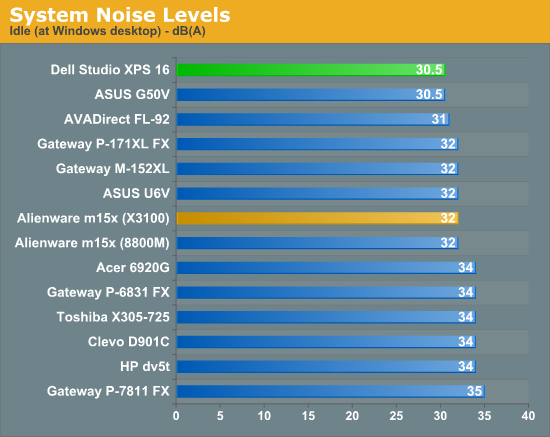
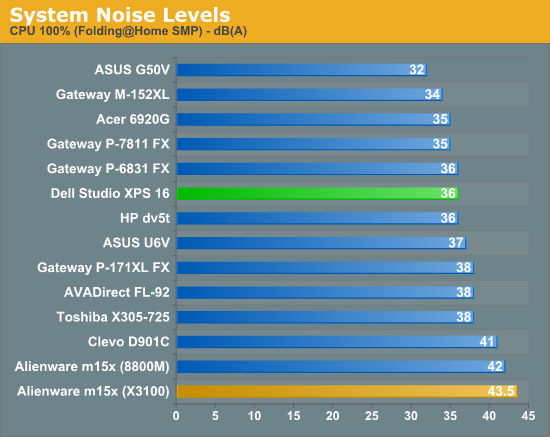
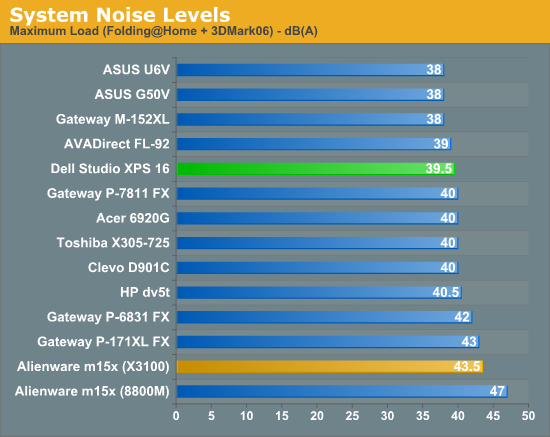
The Studio XPS 16 does reasonably well in terms of noise levels, almost reaching the noise floor of our testing environment (around 28 dB). Once you start to put a load on the system, it does get a bit louder, and extended gaming will usually reach maximum noise levels after a few minutes. The system also takes a while to quiet down after you remove the load, which is likely influenced by the top panel partially blocking the exhaust port.
Temperatures
We didn't create any charts, but we wanted to give a quick rundown of the temperatures you might expect from the Studio XPS 16. We placed a maximum load on the system for 30 minutes and then measured temperatures, so these results are something of a worst-case scenario. Then again, the testing environment was only 67°F, so in warmer conditions it might not be as difficult to make things toasty. We have heard some complaints from users about the XPS 16 getting excessively hot; we wouldn't go that far, but it definitely doesn't run cool to the touch all the time.
We measured temperatures of ~45°C at the exhaust, which isn't too bad. However, temperatures on the bottom of the laptop range from 35° to the 45° as well, with large portions of the bottom measuring above 40°C. The keyboard and palm rest weren't quite as hot, ranging from 30° to 40°C with most of the keyboard staying under 35°. Just to put things in perspective, those temperatures are higher than what we measured on the Toshiba X305-Q725, a result of the smaller chassis with fewer fans.










79 Comments
View All Comments
MadBoris - Monday, April 6, 2009 - link
So with this review getting the juices flowing, and the aformentioned sale coming tomorrow I started reminding myself why I want this Lappy.Here is a rundown on why I decided on this lappy as my next lappy purchase, in no particular order:
* 64 Bit OS standard, everything works w/ 64 bit.
* 1920x1080 with RGBLED in a 16" screen.
* Blu Ray drive option, 1080p natively supported.
* 2.1 speakers with built in subwoofer, impressive for a laptop.
* Sturdy construction, no flex in chassis or keyboard.
* CPU using 1066 FSB rather than 800.
* 4GB DD3
* Firewire port
* Full digital HDMI
* Display port
* eSata port
* 3 powered USB's(optionally powered when PC is off).
* Backlit keyboard with good key orientation, size and sensitivity.
* Synaptics touchpad, nicely textured, with multitouch support.
* 500 GB 7200 RPM drive or great 256GB SSD upgrade.
* Webcam built in for video conferencing.
* Facial recognition software for security, it's a cool tech toy atleast.
* Included Lojack for a year, at least used to be offered.
All for a good price IMO.
The only big drawbacks:
* While beautiful black obsidian and leather, it's a finger print magnet.
* Gets hot when it's being stressed hard, even to the touch below the touchpad.
* 3670 GPU not a ATI 4xxx. But if it had more GPU there would be no reason to get any of Dells XPS laptops for gaming. I have a gaming machine, I don't do laptop gaming.
* Battery 6 cell life is under 2 hours. But getting a seperate 9 cell for $80 fixes that issue.
* Viewing angles on TN panel, but it's a lappy like others.
* Built in TV tuner not available in USA, :sad:.
None of those drawbacks are showstoppers for me, all of the positive features it comes with make up for it easily.
MadBoris - Monday, April 6, 2009 - link
Sales have not been seen on this laptop since a couple days back but...Just a heads up, a new 2 day sale on the XPS 16 starts tomorrow. Who knows, this may be the one that has me pull the trigger.
Specifics unknown, but I imagine it will be like the $363 off from the other day.
Starts 6AM, April 7th.
http://www.dell.com/xpsevent">http://www.dell.com/xpsevent
charleski - Monday, April 6, 2009 - link
Nice gamut, but a TN panel means the gamma of the display will visibly vary with viewing angle. This makes is unsuitable for serious photo editing or any application that requires accurate colours and tones unless you take pains to maintain a consistent view angle. Still, probably no worse than a MacBook Pro.Since a high-gamut display is really only of any use to people running colour-managed applications, the large gamut is actually a disadvantage to those who just want to run apps, and movies may appear to be over-saturated.
MadBoris - Monday, April 6, 2009 - link
Yep, that is a problem, people get the over saturated impression. It's too vivid.Reminds me of when people go from CRT to LCD/Plasma. It looks really over bright and over saturated but most techies have become accustomed to that now and forgot what that transition was like. But now going from CCFL to RGBLED takes it up another notch.
Problem is source material like movies that are post processed to look a little more vibrant on CRT TV's really look over saturated and even unnatural on the RGBLED. But given enough time the eyes and mind will become accustomed to it even if it's a bit unnatural. The RGBLED is just a bit too vibrant for some.
CSMR - Saturday, April 4, 2009 - link
This monitor has displayport and hdmi output.That's a point that deserves more attention IMO, since notebooks with dual digital video outputs are very rare indeed.
One question I would have is can they both be adapted to DVI, just because displayport is not common yet. If it can't be adapted, that limits dual-display options but is still better than nothing!
JarredWalton - Sunday, April 5, 2009 - link
The laptop didn't include any adapters for DisplayPort to DVI or HDMI to DVI, so I couldn't verify this aspect of the laptop. Dual digital outputs is great, I agree. Of course, if you have to use DisplayPort without an adapter, I think you might be limited to Dell LCDs for the time being.cvt - Friday, April 3, 2009 - link
Jarred,I have one of these notebooks, similar spec except with the hotter T9550.
Originally it came with the 320gb 7200rpm HDD, I have since changed it to a 80gb Intel X25-M.
The heat in the palmrest and touchpad areas of the notebook are noticably cooler. The rest of the notebook, including keyboard and base are basically unchanged. The next stage I went through was undervolting the CPU. I was able to shave 0.275v off and remain completely stable. Heat overall dropped, but not dramatically. Same can be said about battery life, without timing it, I haven't noticed any major improvement, 15min max. Even after these steps It is still noticably warmer than any of my previous notebooks (recent, D820, D830, E6500). Taking into account the hardware, and changed I made, all things are pointing to the GPU being the cause of heat.
Admitadely I have no solid data to go off, but current observation leans that way.
Slappi - Friday, April 3, 2009 - link
I have been an Anandtech reader since the start but your ATI bias is getting too obvious to ignore.Please don't go the way of TH.
JarredWalton - Friday, April 3, 2009 - link
Bias against ATI or for ATI?In the case of desktops, we've been recommending plenty of ATI cards. If it's not clear from this review, I *don't* like the idea of ATI mobile GPUs if you're concerned with driver updates. NVIDIA only provides quarterly reference drivers for laptops, but that's better than not getting any support other than the manufacturer.
From a performance standpoint, the ATI HD 3670 is better than the GeForce 9600M and lower (8700M and lower), but the 8800M/9800M/GTX 280M are all substantially faster. If you only need moderate performance, and you don't care a lot about gaming, I'm perfectly fine with running ATI GPUs in a laptop. I'd even go so far as to say my experience with ATI drivers has been better than NVIDIA drivers in terms of compatibility, just as long as you're not running CrossFire. That the August 2008 drivers Dell incorrectly installed (unless the driver version just showed up wrong) ran Far Cry 2, Fallout 3, etc. without any noticeable issues is a lot better than I would expect.
Going forward, I've got the first high-end ATI GPU in a laptop that I've seen in over two years right now, which I'm excited to test, but it's a 4870X2 CrossFire solution so I'm *really* worried about drivers - and I say that after having seen way too many issues with NVIDIA's earlier SLI laptop drivers. Anyway, the last high-end ATI mobile GPU I tested was a Mobility X1800 in an Alienware, and that review never saw the light of day because of other laptop problems.
If anyone is biased against ATI, I'd say it's the notebook manufacturers, who have begun to stay away from ATI options for the most part. I can find dozens of 8800M, 9800M, and now GTX 280M laptops for purchase from a variety of sources. How many 3850/3870 laptops are out there? None from Dell, HP, Gateway, etc. A quick search only finds one online. Heck, http://ati.amd.com/products/hd3000partnersproducts...">even AMD doesn't even list any 3800 series partner laptops! (I couldn't find any list for 4600 or 4800 either.)
Personally, I try to be as impartial as possible in my reviews, and I'm at a loss as to what bias there was in this article. Discussing the lack of reference drivers from the GPU manufacturer isn't bias, it's a fact. If you want to point out specifics other than that, however, I'm open to listen to where I've been overly harsh.
Pirks - Saturday, April 4, 2009 - link
Alienware M17 has ATI 3870 (or two of them in CF) inside. AWESOME notebook for gaming, and only $1400 - best bang for buck gaming wise you could find.